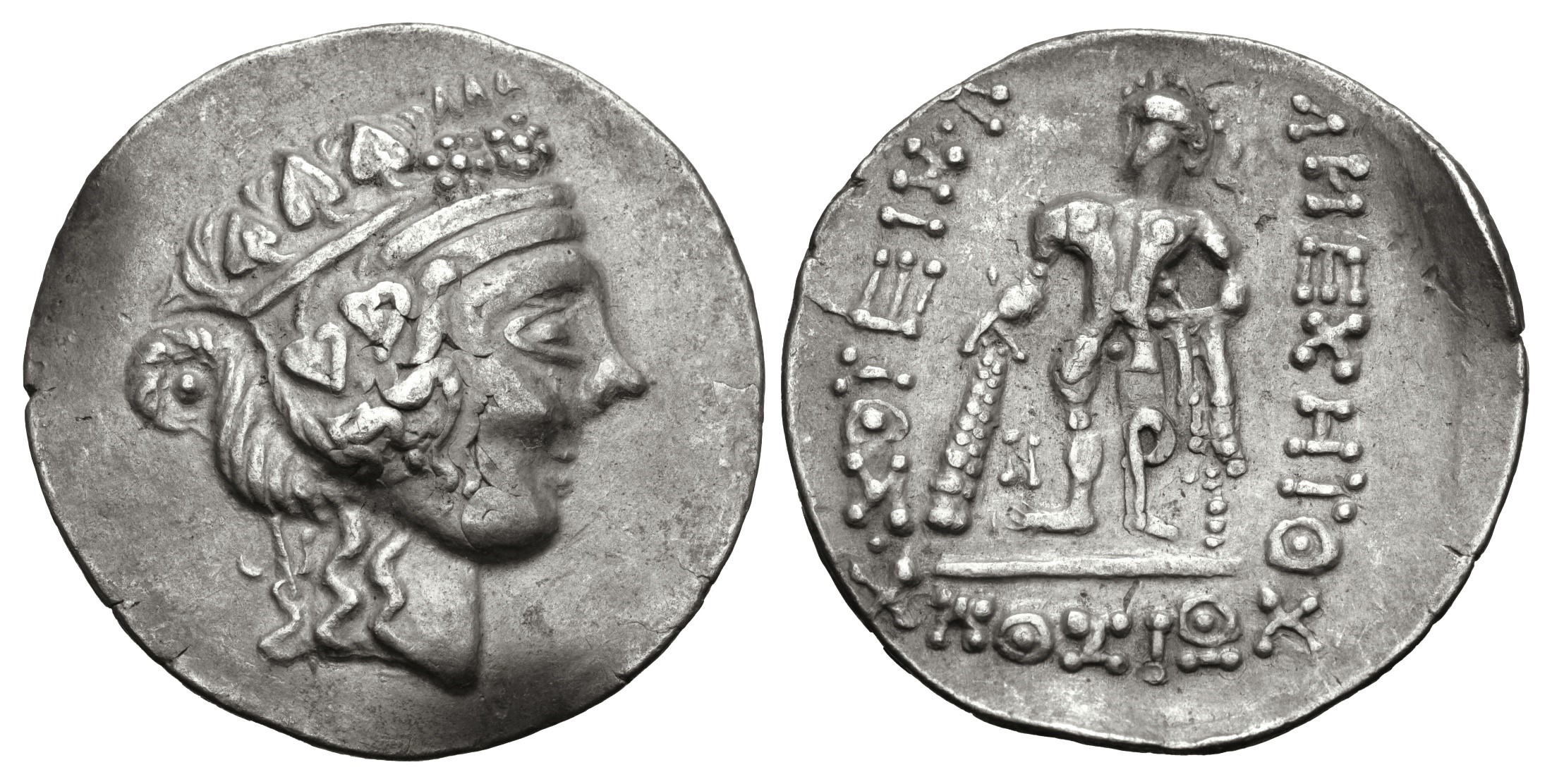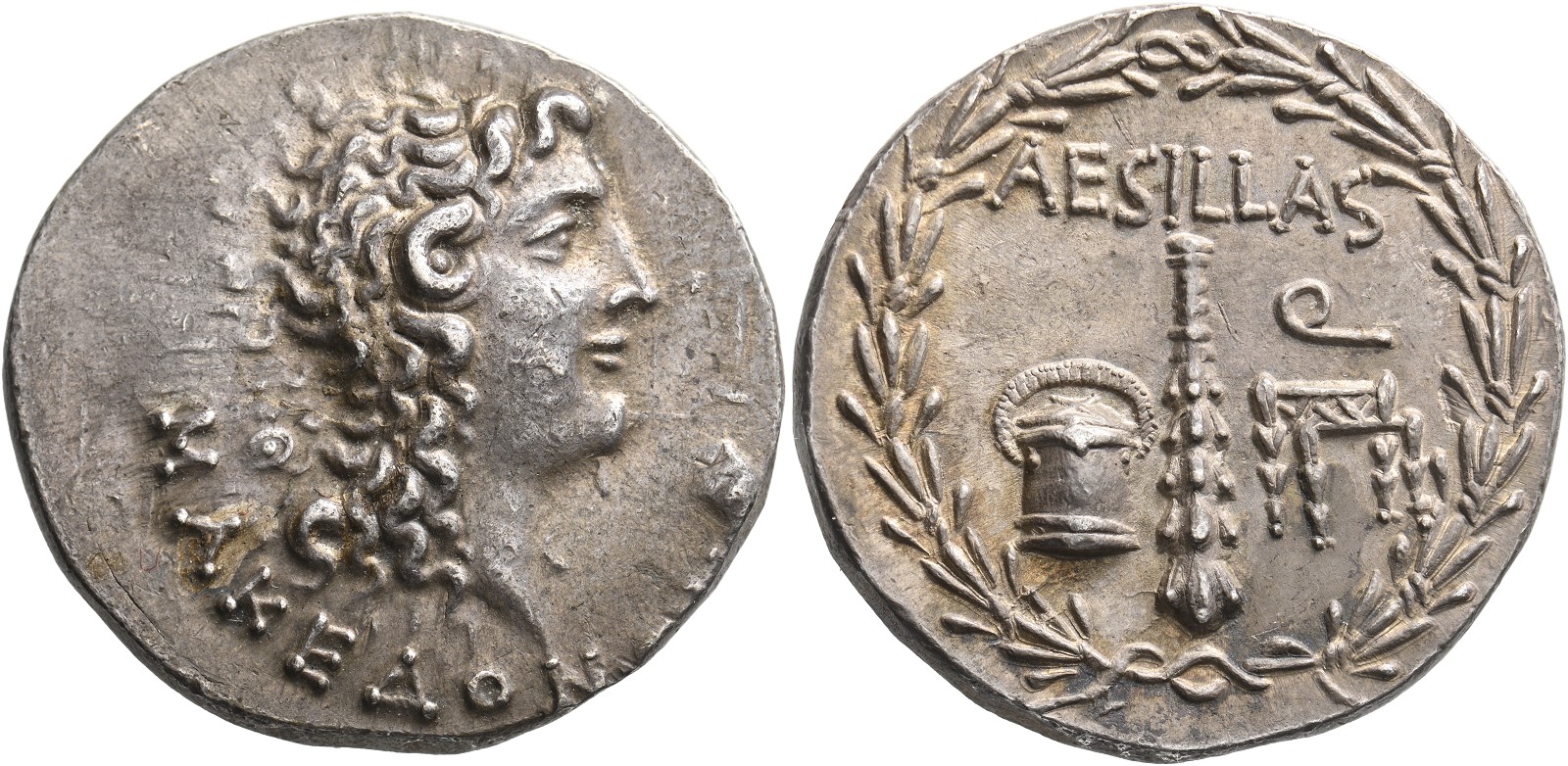70 BCE - 50 BCE | HPAKΛEOYΣ / ΣΩTHPOΣ / ΘAΣIΩN
Overstriking coin
Thasos on Aesillas? - Classical Numismatic Group, E-Auction 477, 23 Sept. 2020, 215.jpg
[1]
Overstruck variety
Thasos on Aesillas? - Classical Numismatic Group, E-Auction 477, 23 Sept. 2020, 215 overstruck variety.jpg
|
|
Sale(s)Sale(s) ᵖ:
|
Classical Numismatic Group, E-Auction 477, 23 Sept. 2020, 215 = Heritage 3020, 7 September 2012, 24934
|
| Private collection(s)Private collection(s) ᵖ:
|
From the Toliver Besson Collection. From the R. G. Collection
|
|
Description
| ObverseInscription or printing placed on the obverse.:
|
Wreathed head of young Dionysos right
|
ReverseInscription or printing placed on the reverse.:
|
HPAKΛEOYΣ / ΣΩTHPOΣ / ΘAΣIΩN (Greek) Stylized Herakles standing right, holding club, lion skin draped over arm, N to inner left, legend highly degraded
|
Mint and issuing power
| MintIdentifies the place of manufacture or issue of a numismatic object.:
|
Thasos
|
Ancient regionAncient region.
|
Thrace
|
Modern countryModern country: Greece
|
AuthorityIdentifies the issuing power. The authority can be "pretended" when the name or the portrait of X is on the coin but he/she was not the issuing power. It can also be "uncertain" when there is no mention of X on the coin but he/she was the issuing power according to the historical sources:
|
Roman Republic
|
Chronology
| FromIdentifies the initial date in a range assigned in a numismatic context. 70 BCE toIdentifies the final date in a range assigned in a numismatic context.. 50 BCE
|
Hellenistic 323-30 BC  periodTime period of the numismatic object. periodTime period of the numismatic object.
|
Physical description
MetalThe physical material (usually metal) from which an object is made.: Silver 
|
WeightWeight of the numismatic object (in grams). in grams: 16.3916.39 g <br />16,390 mg <br />
|
DenominationTerm indicating the value of a numismatic object. Examples: tetradrachm, chalkous, denarius.: tetradrachm 
|
AxisDescribes the directional relationship between the obverse and reverse of a numismatic object.: 11 mm <br />0.1 cm <br />
|
| DiameterDescribes diameter of an object (in mm).: 3333 mm <br />3.3 cm <br />
|
StandardStandard.: Attic
|
References
Description
| ObverseInscription or printing placed on the obverse.:
|
MAKEΔONΩN (Greek) Head of the deified Alexander the Great right
|
ReverseInscription or printing placed on the reverse.:
|
AESILLAS (Latin) Q Money chest, club, and chair, all within laurel wreath
|
Mint and issuing power
Chronology
| FromIdentifies the initial date in a range assigned in a numismatic context. 95 BCE toIdentifies the final date in a range assigned in a numismatic context.. 65 BCE
|
Hellenistic 323-30 BC  periodTime period of the numismatic object. periodTime period of the numismatic object.
|
Physical description
| DenominationTerm indicating the value of a numismatic object. Examples: tetradrachm, chalkous, denarius. ᵖ:
|
tetradrachm 
|
StandardStandard. ᵖ:
|
Attic
|
References
References
- ^ Lukanc, Ivo (1996), Les imitations des monnaies d'Alexandre le Grand et de Thasos, Wetteren, Cultura
- ^ Hoover, Oliver D. (2010), The Handbook of Greek Coinage Series, volume 6 : handbook of coins of the islands: Adriatic, Iionian, Thracian, Aegean, and Carpathian seas (excluding Crete and Cyprus), sixth to first centuries BC, Lancaster, 358 p.
- ^ Callataÿ, François de (1996), "Les monnaies au nom d'Aesillas", in T. Hackens (ed.), Italiam Fato Profugi Hesperinaque Venerunt Litora. Numismatic Studies Dedicated to Vladimir and Elvira Eliza Clain-Stefanelli, Numismatica Lovaniensia 12, Louvain-la-Neuve, p. 113-151.
- ^ Bauslaugh, Robert A. (2000), Silver coinage with the types of Aesillas the Quaestor, Numismatic Studies 22, New York.


